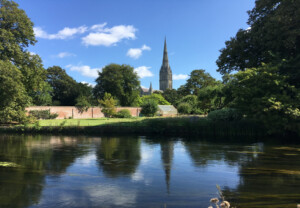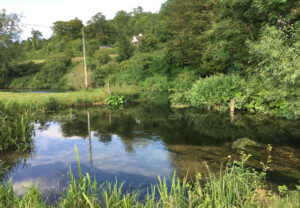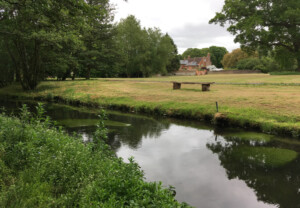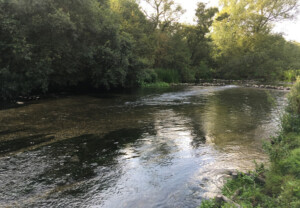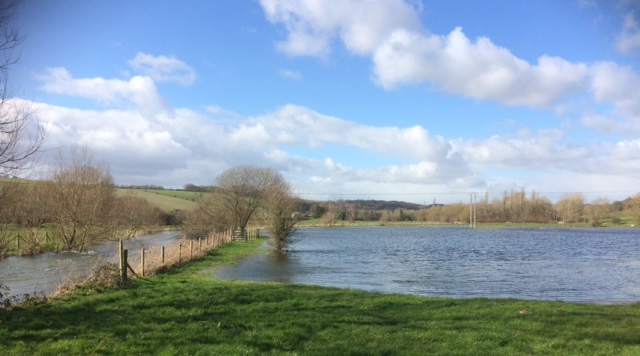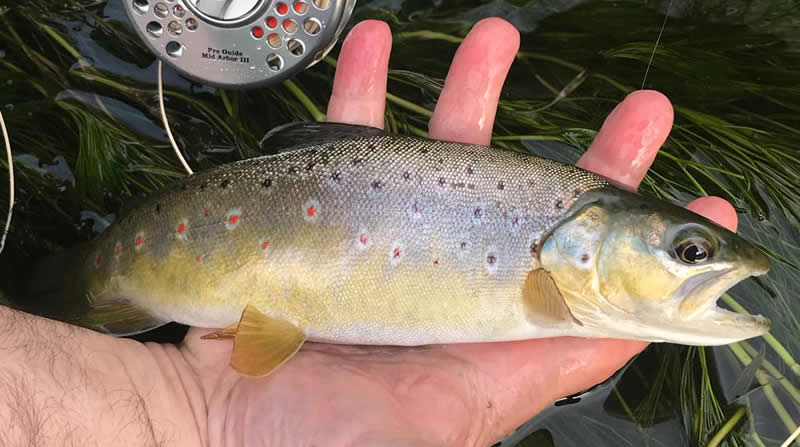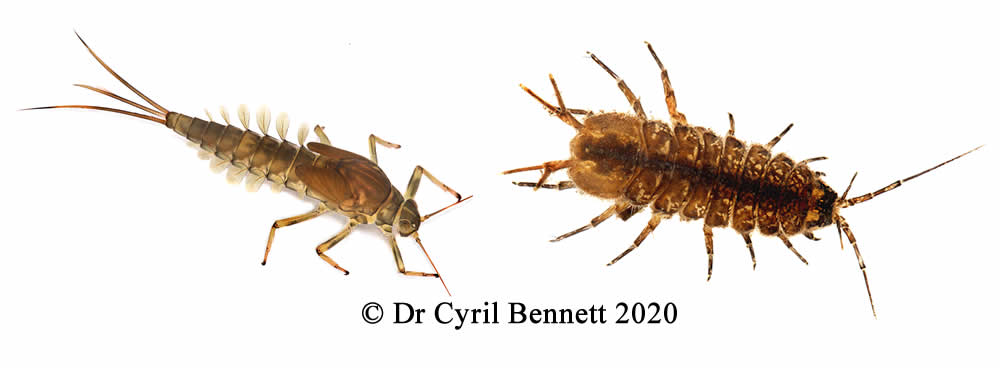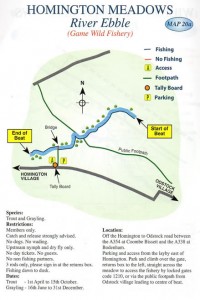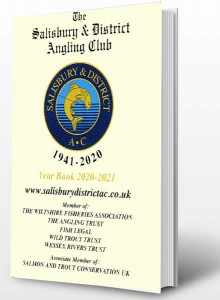Season Outlook
Technically, March is the start of spring. Realistically, year on year it feels like winter does not want to let go. This year in particular watching the pelting rain, hearing storm after storm causing devastation does not exactly fill one with joy. The news about corona virus spreading and its impact on our daily lives has an additional burden on the way we feel. Health? Holidays? Travel? Economy?
However, there is one thing that fills me with excitement. Only a few weeks before the start of the season! From where I am sitting at the moment it will be a superb season. Let me explain why.
What drives our sport is the frequency and intensity of fly hatches, starting with large dark olives and grannom in April, continuing with mayflies in May, enjoying the small olive and blue wing olive spinner falls in summer and having good sport with sedges and pale wateries when the weather gets cooler in autumn.
It is by now scientifically proven that our flies have three main enemies. First of all accumulation of silt on the river bed, a result of run off from roads and cultivated fields. Secondly, increasing amounts of phosphates from agriculture and sewage water treatment plants. Thirdly, pesticides and other chemical compounds that may find their way into the rivers. If you add low water conditions and decreased river flows the negative effect on our fly life is exacerbated.
Not this year though. The aquifer recharge has been the earliest that I have witnessed in the last 10 years I have been working for the club. The river Till has been running in the village of Shrewton, about 3 miles North of Stonehenge, from early December and the ground water level is 9 metres higher than last year! Inevitably the river flows have been very strong throughout the winter months and one can start seeing sparkling clean gravels in the shallows. The expectation is that most harmful compounds have been washed away.
I am personally optimistic about our fly hatches this year and I can compare it with 2014 when we had similar water conditions.
Fishing on the other hand will get a lot more interesting. You should expect trickier currents which would cause your flies to drag and twist unnaturally putting a fish down the very last minute. High water velocity normally means plenty of weed growth. Great shelter for invertebrates and fish, but challenging casting. Accuracy and presentation skills are required when one needs to place ones cast in between the weed rafts where a fish rose temporarily. It will not be as easy as casting a fly in low water conditions, watching your fly gently drifting with the slow current hoping that a fish might grab it the last minute.
Patience, observation and stealth will be your best weapons. Minimise your casting and learn to observe the water and actually detect the rises. A little disturbance in the water next to the bank, or a tiny ripple in between the weed are the signs you are looking for. The bigger the fish the smaller the rise. Do not expect splashy rises and fish doing cartwheels. This rarely happens.
My prediction is that the flies and the fish will be there in good numbers to greet you. Have an enjoyable season!
Andreas Topintzis
Club General Manager
Game Update.
We approach the 2020 season with aquifers brim full and our rivers running very high. We may see some restrictions to fishing beats on April 1st and certainly indications are that the early days will be hard going. We have said before though that the best method of river restoration is simply more water. It always seems to bring improved weed growth, clean gravels and we hope it clears out some of the nutrients affecting the water quality.
The keeper team has been out clearing fallen trees on many beats, using them for habitat where we can. Bank maintenance will start as soon as we can get machinery to the beats but some areas will probably have to wait beyond the start of the season. The winter has been a busy time responding to blocked hatches, finishing the enclosure of our woods at West Amesbury, assisting coarse side with the issues arising at our lakes, controlling predators, building bridges, seats and stiles, re establishing some bramble free fringes and more.
Members will have already noticed a lot of work done particularly at Leominstead lake for habitat and member comfort. We have further plans for both lakes and we are happy to say that after disappointing results for a couple of years the revised stocking pattern, predator control and other changes are bringing an upswing in our catch returns. We have signed a new lease for Hamer and Leominstead comes up for renewal soon. Both lakes are firmly in our portfolio now we are getting the results we want to see. We are still planning to close the lakes this season for June, July and August as fish become torpid in hot weather, we can’t stock because the fish too easily die , the keepers are busy on the rivers, the lakes will get a rest. Temperatures above 19 deg C see salmonids start to decline and we have recorded summer temperatures of up to 25c in our lakes. Hamer perhaps has a better chance of keeping stock in good health but they will hide in the deepest water even there. We will see how this summer goes and review the policy, if we find a way that we can selectively open in cooler weather we will see if we can do so.
We have talked to Charles Jardine , a member and known to most as a great angler, writer and artist. He is a great fan of Hamer Lake believing it to be potentially one of the best still water rainbow lakes in the area. He describes it as difficult and all the better for that, the water is crystal clear, members need to know how to cast, need to consider their gear , lines , leader length and turnover and need to be ready to ring the changes on fly choice. The lake has good weed growth and an abundance and variety of natural food. He describes the skill level required for Hamer as more akin to the rivers than other small still waters.
With Charles and maybe other experts we hope to organise some evening sessions at Hamer, informal and geared towards understanding and appreciating the lake and what might be needed for success. Anyone who wants to fish with Charles and talk about the challenges the lake presents will be welcome.
Charles has offered to lead two informal sessions at Hamer helping members get the best from this special water.
Friday evening 3rd April
Saturday 11th April
Members only, limited places.
Please contact Kris Kent in the first instance: kriskent@hotmail.co.uk
The figures for the two lakes for this year are below.
| HAMER | LEOMINSTEAD | |||||||
| VISITS | CAUGHT | TAKEN | RA | VISITS | CAUGHT | TAKEN | RA | |
| Sep-19 | 16 | 3 | 3 | 0.01 | 17 | 0 | 0 | 0 |
| Oct-19 | 59 | 39 | 16 | 0.66 | 57 | 33 | 13 | 0.57 |
| Nov-19 | 48 | 24 | 12 | 0.5 | 45 | 50 | 28 | 1.1 |
| Dec-19 | 31 | 10 | 5 | 0.32 | 54 | 36 | 25 | 0.66 |
| Jan-20 | 37 | 28 | 17 | 0.75 | 26 | 26 | 17 | 1 |
Rod average= caught over visits. Target 1.5
Cormorant control introduced at Hamer 15/1/20
Please read your 2020 membership books carefully, there will be a few changes to the maps and instructions at some of the fisheries. Recording visits and catches accurately in the return books is very important to our management of the fisheries. Stocking for 2020 will be the same as last year, Durnford, West Amesbury , Abbey , Ratfyn/Countess, Stapleford will be getting fish. We stock areas of high angling pressure and poor trout habitat only. This year’s fish will be marked with a yellow tag by the dorsal fin. It is very important to record colour tagged fish caught as they tell us a lot about stocking needed, year to year survival and migration of fish. If you take fish for the pot please take the tagged ones, our wild stock are too precious to kill. Wild brown trout of the size that might be attractive for the table are our prime breeding stock, fish of three years plus and about 10 inches upwards are the ones we must preserve to keep a healthy breeding population. We don’t make this a rule but advise strongly that members follow this guidance. Please return your fish carefully , keep them out of the water as short a time as possible, use barbless or debarbed hooks, be particularly careful with grayling as they tend to be more likely to succumb after capture and the population needs all the help we can give it.
Through the winter the Wessex Rivers Trust has been helping us to survey all of our river beats, up and down stream of Salisbury, with a view to mapping the habitat and identifying areas needing improvement. Real plans for habitat works will be coming out of this. We are grateful to Matt and Maddie from WRT and to the EA who gave the £10,000 grant supporting this work. It will enable us to improve our waters and be ready with defined schemes as any funding opportunities arise. We have already submitted an outline for works at Stapleford to the Fishery Improvement Programme run by the EA which draws on license fee monies and puts them back in to the rivers and lakes.
The land acquired by the club alongside our existing fishing rights at West Amesbury has now been fully enclosed with a fence behind the football field and alongside the recreation ground. We intend to manage these areas for wildlife gradually improving the woodland and meadow land on the Queensberry bank. This is not our main purpose or priority so anything we do will be as time permits but already we are seeing that we have a good list of birds, plants and amphibians spotted. There are still a few trees looking a bit precarious although we have dealt with the obvious dangers. In time we want to open the main glades to members via a bridge from the bank above Ham Hatches with one of the glades having facilities for picnics/lunches. We also want to develop a return path from the upper beat back through the wood to avoid disturbance on the bank. If any members have an interest in assisting with the reserve please let us know at the Cartshed. We already have Andy helping us with compiling a species record, two of us are dealing with the clearing, mowing, litter etc. If anyone is familiar with building and installing bird boxes we would love to hear from you.
The weed cutting dates are as usual published in your Year Book, page 33 and online HERE This year we may see heavy growth as it often happens after we have had a lot of water through. We will be continuing the practice of lighter hand cutting on most beats as we have done in the last few years. Deeper slower beats will be cut by our contractor with a boat, he will be coming to us for the first time this year as the owner of Waterplant has decided to retire, thanks to them for years of support with our weed cuts. The new contractor will be covering all the clubs and owners on the Avon making his trip to the area more economical for us all. Check your book for the dates and remember the weed continues travelling through the system for some days after the cut. Weed cutting is organised as a partnership between Wiltshire Fisheries Association, the clubs/owners and the EA. The EA extract the cut weed south of Salisbury and dispose of it, they also issue the permits for the cutting. Wiltshire Fisheries Assoc. coordinate the dates with the EA, clubs and owners and coordinate cutting on the rivers. The keepers organise the cutting and chase the weed through the system clearing any hatches and structures as they go. With the fishing at Durnford we sit at the lower point of the river for cutting so we must shepherd all the weed from the whole Upper Avon system through to the boom below New Bridge at Harnham. If anyone feels able to offer some time to assist with the cutting let us know at the office, we will try to let members know which areas will be cut and when via the forum.
Kris Kent who joined the committee last year has been surveying members to understand skill levels of our anglers, a good number have expressed an interest in some teaching sessions on the rivers and Kris and Andreas will be going ahead with this during the season. As usual we will hold our game fishing open day in the early season, see the handbook again for dates. We will be at Amesbury Abbey again this year which has proved to be a very successful venue.
Tight lines in 2020.
John Stoddart ,Vice Chair Game.
Membership Survey
Thank you to the 403 members that took the time to complete the Membership Survey that went out in early January. We wanted to understand the appetite for a programme of tuition and coaching within the club. A programme that would help develop members angling competency and ensure they get the most from their membership.
44% of the respondents, 179 members, said that they would be interested in such a programme, whilst 127 members, 31%, said maybe. With 75% of response being positive we are now looking to develop some pilot courses which we will launch this spring, which, if successful, we will roll out through the year and across both coarse and game disciplines. The full set of results are available on the website –
Academy Programme
The recent membership survey demonstrated a high level of interested within the club for a programme of tuition, instruction and coaching.
We will be running two pilot courses in April / early May. The first course is designed for people new to fly fishing on chalk streams and the second for people who have some experience of fly fishing on rivers and who want to improve their early season fishing. They will be a combination of classroom and on the water. Both one day courses will be run by one of our highly experienced members who is also a qualified coach and will cost just £40.
Further details and dates will be published very soon both here and on the forum.
Salisbury River Corridor
John Stoddart, Dave George and Paul Clancy met with Wessex Rivers Trust to be briefed by the EA about proposals to develop the “Salisbury River Corridor” . This would change the river above Ashley Rd and down to Sainsbury’s. A briefing note from the EA is published here and we will be keeping a close eye on this development. So far we are reasonably happy with the proposal but have raised several areas of concern and interest with the EA.
Entomology
A year of invertebrate surveying on the Avon at Queensberry has taken some of the novelty out of the experience, but still satisfying in a different way. For the first time I feel like I’ve been risking life and limb for the data, first by driving through atrocious weather and London traffic to get to Amesbury in the winter of 2019/20 and secondly by getting up to my armpits in a swollen Avon for the sake of having a few numbers to talk about during our monthly committee meetings.
The Queensberry stretch is far more interesting to survey than Lord’s Walk which I surveyed previously. For starters there are no water hog louse here to be found and that’s a massive relief because I’m afraid I just find them ugly. Secondly the Queensberry stretch has plenty of ranunculus in the summer and a fair bit of stones to peer under. The water flows much more quickly here beneath the bridge too.
While I had dog walkers to contend with at Lords Walk, one or two were quite interested in what I was doing and why. Queensberry Bridge by contrast is a bit more of a distance away between me and the public, and you can expect the odd heckle from the spotty youth and if you’re lucky a pebble or two chucked at you. On one occasion while I was removing my waders by my car, I was approached by a van that parked remarkably close to me. I was concerned that this might be some sort of idiot about to hurl some abuse, but in fact it was a fellow angler from Bridgewater who had moved to Wiltshire and was keen on finding a bit of river pike fishing. He expressed mild interest in my invertebrate surveying activity.
To be honest I haven’t found many coarse fishermen that are interested in insect life. The fact is the people who equate the health of the invertebrates with the health of the water, are few. There are significant numbers of dog walkers that believe a pristine chalk stream is a resource to be used as a convenient dog wash.
Hans Staartjes.
Open Day 2020
This years Open Day will be held at the Abbey Fishery on Sunday 24th May. There will be the usual mix of instruction, entomology and fly tying with lunch included. A great opportunity to meet the committee and fellow members and to raise your game ready for the season ahead.
All members welcome, further information and booking details will be published very soon.
The SADAC River Spawning Habitat Improvement Project
There can’t be many people who have not heard of The Avon Roach Project, a 10 year initiative conceived and executed by Budgie Price and Trevor Harrup to enhance the Avon Roach population by collecting spawn from the native fish and rearing it away from the river before returning the resultant stock at about three years old. For those unaware of the project there is a wealth of information on-line and it is fascinating stuff.
The ARP has now ceased its major operations as after ten years of effort and damn hard work there is no doubt that the Middle Avon and Lower Avon Roach populations are now at healthy and hopefully self-sustaining levels. The ARP was triggered by the Roach population crash on the Middle River and has largely focused its efforts on those reaches, but of course the upper river, of which most of the coarse fishing is controlled by SADAC, also largely lost its Roach shoals. During the same ten years of the ARP the Club addressed this loss by stocking Roach harvested from local stillwaters, some of which were out of catchment, and although undoubtedly successful this practice is now officially frowned upon, and as our fisheries are SSSI’s, potentially illegal. The stocking has now ceased as at the request of the Environment Agency the Club has voluntarily surrendered its Site Permit under which the stocking was authorised.
In order to maintain and sustain our river Roach and other coarse fish populations we have decided to initiate our own spawning habitat improvement project on the river fisheries. Although loosely based on the ARP, and indeed we will probably inherit their famous ‘Spawning Boards’, we also intend to cover the gravel spawning species such as Chub and Dace. We have formed a steering group which will benefit from scientific input from Dom Longley, a Fishery Scientist and Committee Member, and also from the experience of the ARP’s Trevor Harrup himself.
The first step will be to survey our Town and Constable fisheries plus some of the upper beats to identify current spawning areas, potential spawning areas, existing fry survival refuges and potential refuges plus other opportunities to enhance the spawning habitat for our stocks. This will then lead to a plan of work with costings and projections which we can begin to execute ahead of next year’s spawning season. I had actually hoped to include some initial findings from the survey in this report but the exceptionally high water levels and bankside flooding have delayed the start of the survey although I can say that we have already identified several proposals in the potential ‘Salisbury River Park’ scheme that will provide significant opportunities for our own habitat improvement aspirations.
Dave George
Fishing for Forces
Fishing For Forces is our initiative to introduce sick and injured forces personnel, who are participants in the Rolling Recovery Program (RRP) at Tedworth House, to our sport. It is a great opportunity for volunteer mentors to give some time back to the club to help others, and can be very fulfilling. A barbecue lunch is usually provided. Last year we had 4 events. At Calstone Lake in May (new venue, switched to at the last minute due to Manningford being unavailable), in fine weather, 6 guests enjoyed great fly fishing, all catching feisty rainbow trout. In July we went to Nightingale Lake, again in good weather, with 7 guests, and one tench and a number of carp were caught as well as plenty of silvers. In September we fished the Inner Snake at Witherington with 5 guests. After a wet start prior to fishing, the day turned out fine. Again, a number of carp and some silvers were caught, plus a few perch. In October we went back to Nightingale, with 7 guests again. The weather was pretty horrendous and the fishing slow but everybody enjoyed themselves. A couple of carp were landed, some lost, and plenty of silvers were caught. Very enjoyable days, just for fun, not at all competitive, but don’t try and tell the service personnel that!
For 2020, we have 3 events planned:
28th May – fly fishing – venue to be confirmed
2nd July – coarse fishing at Nightingale Lake.
1st October – coarse fishing at Witherington Farm.
Andy Stafford
Helping Hands
For those members that haven’t heard, last year I started an initiative for those members who might have difficulty and doubts about being able to carry on as members of the Club due to being less able bodied in some way.
To this end I set the wheels in motion and my first recipient in April was John Lorford, according to what he told me he thoroughly enjoyed the chance to carry on with his passion, ( 13 trips in total), I believe in only giving as much or little help as needed to let the person enjoy their time on the day, so I keep out of the way until needed.
So if you feel that this would be something you think could help you please contact the Cart Shed in the first instance, the only proviso is you’re being able to get transport to the venue.
Wishing you all a great season ahead.
Andy Bowditch

